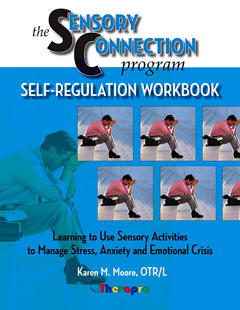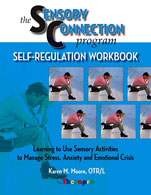The Sensory Connection Self-Regulation Workbook
Learning to Use Sensory Activities to Manage Stress, Anxiety and Emotional Crisis
This workbook was developed to help adults and adolescents learn self-regulation skills that emphasize the use of sensory strategies. Without self-regulation skills, a person in emotional crisis is at risk for substance use, suicide, self-harm or harm to others.

The Workbook
- Provides tools for groups focused on coping and self-regulation
- Coordinates with Trauma Informed Care and Restraint Reduction Initiatives
- Complements DBT and Cognitive Behavioral Therapy grou
- Provides education and specific exercises for individual use by motivated individuals
The Completed Workbook
- Provides a thoughtful Crisis Intervention Plan
- Organizes information on helpful sensory coping strategies
- Facilitates early intervention and the use of the most effective strategies by care providers
- Furnishes plans for stress management in the home and discharge environment
- Serves as a resource for future problematic times to avoid need for hospitalization
Who Can Use this Workbook?
Self-regulation/stress management groups
Occupational therapists
Psychologists, therapists, & counselors
Hospital inpatient psychiatric units
Hospital mental health outpatient programs
Substance abuse programs
State psychiatric and forensic facilities
Adolescent Units
Motivated Individuals
The advantage of this sensory approach is that it relies on physiology rather than cognitive and psychological strategies that are difficult to use when thinking is compromised by severe mental health symptoms or emotional crisis.
Through this workbook, a person learns about the calming and alerting potential of sensory input and learns ways to use sensory activities to deal with anxiety, anger management, stress reduction, and emotional crisis in ways that are healthy as well as fun. Skills include recognizing states of arousal, doing deep abdominal breathing, learning grounding techniques, developing a sensory kit, designing a comfort space in the home, and developing a crisis intervention plan for extremely difficult times.

Follow this link to see a list of the workbook chapters.

